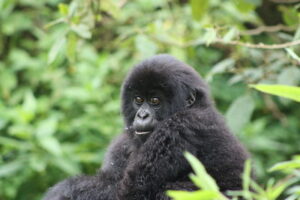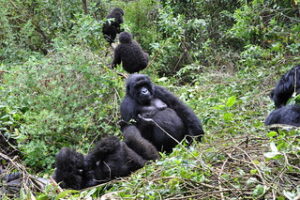A once-in-a-lifetime opportunity to witness one of the most magnificent and endangered creatures on the world in their native habitat is provided by gorilla trekking in Rwanda. Volcanoes National Park in Rwanda is one of the greatest locations for this expedition to meet the human closest relative. But since the gorilla population and its habitat are so vulnerable, there are stringent laws and guidelines to follow to protect both your safety and mountain gorilla protection.
Guidelines for Gorilla Trekking Are Important for their survival
With low population and recoveries over time, Rwanda’s mountain gorillas are under grave threat of extinction. The present rules are intended to:
Protect the mountain gorillas from illness: Gorilla shares almost 98% human DNA which make them vulnerable to human diseases and infection. The rules are there to protect them
Reduce stress and behavioral changes: the presence of human and their action might affect the wellbeing of mountain gorillas. Therefore, the rules are there to protect the mountain gorillas from such unusual behavior
Assure sustainable tourism: To ensure that mountain gorillas and their habitant is not affected by your presence hence ensuring their continued survival
Encourage conservation efforts: Proceeds from gorilla trekking permits are used to fund local communities, conservation initiatives, and continuing research.
Important Rules for Gorilla Trekking in Rwanda
1. License Conditions for Gorilla Trekking in Rwanda
To go gorilla trekking, visitors need to get a permission. The Rwanda Development Board (RDB) or authorized travel operators provide permits to the gorilla trekkers. The permit costs 1500 us dollars and only one group of 8 people is allowed to view a gorilla family a day
2. Minimum Age for Gorilla Trekking in Rwanda
In order to obtain a permit for gorilla trekking, travelers must be at least 15 years old. This is to ensure that the trekkers can adhere with physical demand of the trip and able to observe the required behavior when interact with gorillas
3. Health Safety Measures for Gorilla Trekking in Rwanda
Guests must be in good health. People who are sick with the flu, a cold, or any other infectious ailment are not allowed to hike. This is because gorillas to can be infected by these diseases
4. Time constraints and group size
There can only be eight tourists per mountain gorillas group each day. They can only stay with gorilla for one how with a view to minimize the stress to mountain gorillas
5. Behavioral Standards
Certain behavioral requirements must be followed by visitors both on the journey and when seeing the gorillas:
Keep a safe distance
You should always keep a least of 7 meters, or 21 feet, between you and the gorillas. This keeps the mountain gorillas from being stressed and helps stop the spread of sickness.
Remain still and composed
the mountain gorillas may become agitated by sudden movements or loud noises. It is requested that guests converse quietly and refrain from making needless movements.
Observe the directions in the guide
Every trekking party is accompanied by qualified guides. Their guidance is essential for both the security of the tourists and the gorillas’ well-being.
Avoid using flash photography
Gorillas can be startled by flash. Flash photography is therefore strictly forbidden.
No eating or drinking in the presence of gorillas: Visitors are not permitted to eat or drink in the gorillas’ vicinity in order to reduce the possibility of illness transmission by food or drink.
6. Environmental Aspects for Gorilla Trekking in Rwanda
In order to conserve the ecosystem, visitors must abide by the following rules:
Leave no trace
You are required to remove all trash from the park. It is completely forbidden to litter.
Follow authorized trails
Visitors must remain on established pathways in order to reduce disruption of the habitat.
Reduce the amount of plastic you use because it can harm wildlife and the environment
It is advised of visitors to use as little plastic as possible and to dispose of any plastic waste properly.
7. Sensitivity to Culture
It is imperative to show respect for the customs and local populations.
Respect local communities
When engaging with local communities, visitors ought to exercise consideration and courtesy.
Encourage local endeavors by supporting the local economy and community by using locally produced goods and services.
Suggestions for Realistic Gorilla Trekking in Rwanda
1. Physical Readiness
Trekking with gorillas can be physically taxing. Depending on where the gorilla troop is the journey will take between one to eight hours. Therefore, trekkers should be in good physical health to cop with these demands.
-
Proper Equipment
Having the appropriate clothing is essential for a pleasant and secure hike:
Robust hiking boots: Ankle support and waterproof, high-quality boots are a must.
Long sleeves and long pants: These shield the wearer from insect stings and plant scratches.
Rain gear: The alpine weather is often erratic. It is advised to wear waterproof pants and jackets.
Gloves for gardening: These can shield your hands from harm as you move through thick foliage.
To guard against exposure to the sun, wear a hat and sunscreen.
Repellant for insects: To protect against insects.
-
Safety and Health of Gorilla Trekking in Rwanda
It’s critical to ensure one’s health and safety while hiking:
Snacks and hydration: Bring enough water and energy-boosting foods for the hike.
First aid kit: It can be helpful to have a compact first aid kit that contains basic supplies like bandages, disinfectant, and painkillers.
Personal medications: Make sure you have any that you may require on hand.
-
Conservation Attempts and Advantages for the Community
Rwandan gorilla trekking makes a substantial contribution to local communities and conservation. A portion of the permit money is allocated directly to community development and conservation initiatives. This is beneficial:
Protection of the habitat:
To ensure the survival of the gorilla species, funds are used to maintain and safeguard the gorilla habitat.
Measures to prevent poaching:
Income funds patrols and programs that prevent poaching, which is essential to the gorillas’ safety.
Research and observation
The money collected from these fees is used to support ongoing studies and observations of gorilla behavior and health.
Community development:
Jobs and revenue-sharing schemes that fund healthcare, education, and infrastructure development are only two ways that tourism helps the local community.
-
Moral Aspects
Although gorilla trekking offers a unique experience and contributes to conservation efforts, it also brings up significant ethical issues:
Animal welfare: It is crucial to make sure that tourism has no detrimental effects on the well-being of gorillas. This calls for constant observation and stringent respect to rules.
Local communities may be impacted by the influx of tourists. It is imperative that tourism be managed in a way that Honors and supports these communities.
Sustainable tourism practices: Supporting sustainable tourism practices guarantees that the long-term advantages of gorilla trekking do not jeopardize gorilla populations or the ecosystem.
In summary for Gorilla Trekking in Rwanda
Rwandan gorilla trekking provides a once-in-a-lifetime chance to interact with one of the most amazing animals on the globe in their natural environment. Strict laws and guidelines must be followed to preserve and conserve mountain gorillas while giving tourists a once-in-a-lifetime experience. Following these rules makes sure that this amazing activity may go on in a sustainable way, which is good for the gorillas and the communities around. We can help ensure these amazing animals have a future by supporting current conservation efforts through ethical tourism.





